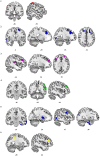Neural correlates of the severity of cocaine, heroin, alcohol, MDMA and cannabis use in polysubstance abusers: a resting-PET brain metabolism study
- PMID: 22768136
- PMCID: PMC3387209
- DOI: 10.1371/journal.pone.0039830
Neural correlates of the severity of cocaine, heroin, alcohol, MDMA and cannabis use in polysubstance abusers: a resting-PET brain metabolism study
Abstract
Introduction: Functional imaging studies of addiction following protracted abstinence have not been systematically conducted to look at the associations between severity of use of different drugs and brain dysfunction. Findings from such studies may be relevant to implement specific interventions for treatment. The aim of this study was to examine the association between resting-state regional brain metabolism (measured with 18F-fluorodeoxyglucose Positron Emission Tomography (FDG-PET) and the severity of use of cocaine, heroin, alcohol, MDMA and cannabis in a sample of polysubstance users with prolonged abstinence from all drugs used.
Methods: Our sample consisted of 49 polysubstance users enrolled in residential treatment. We conducted correlation analyses between estimates of use of cocaine, heroin, alcohol, MDMA and cannabis and brain metabolism (BM) (using Statistical Parametric Mapping voxel-based (VB) whole-brain analyses). In all correlation analyses conducted for each of the drugs we controlled for the co-abuse of the other drugs used.
Results: The analysis showed significant negative correlations between severity of heroin, alcohol, MDMA and cannabis use and BM in the dorsolateral prefrontal cortex (DLPFC) and temporal cortex. Alcohol use was further associated with lower metabolism in frontal premotor cortex and putamen, and stimulants use with parietal cortex.
Conclusions: Duration of use of different drugs negatively correlated with overlapping regions in the DLPFC, whereas severity of cocaine, heroin and alcohol use selectively impact parietal, temporal, and frontal-premotor/basal ganglia regions respectively. The knowledge of these associations could be useful in the clinical practice since different brain alterations have been associated with different patterns of execution that may affect the rehabilitation of these patients.
Conflict of interest statement
Figures

References
-
- Fernández-Serrano MJ, Pérez-García M, Verdejo-García A. What are the specific vs. generalized effects of drugs of abuse on neuropsychological performance? Neurosci Biobehav Rev. 2011;35:377–406. - PubMed
-
- Aron JL, Paulus MP. Location, location: using functional magnetic resonance imaging to pinpoint brain differences relevant to stimulant use. Addiction. 2007;1:33–43. - PubMed

